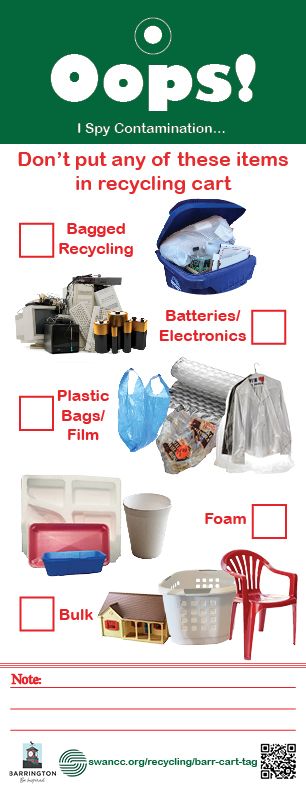In an effort to better understand the issue of contamination, SWANCC has partnered with the Village of Barrington to complete a cart-tagging pilot program. SWANCC and community staff and volunteers will be doing a quick visual inspection of selected resident’s recycling carts. If you have questions about this cart-tagging program please contact Pam at Barrington Public Works, (847) 381-7903.
The pilot will take place in the area indicated below:
Data will be collected on types of contaminants and the levels of resident participation based upon visual inspection of the recycling cart contents. This data will provide communities with information on the the willingness of residents to participate in recycling programs, how well the residents follow the recycling guidelines, and where more education is needed.
Inspections will begin the first week of May, and we will continue to complete inspections every Friday for four weeks beginning the week of May 1st. Inspections are to be completed by SWANCC staff, and Barrington staff and volunteers. The team completing the inspections will be easily distinguished by green safety vests. Please do not hesitate to approach anyone completing inspections for more information. The cart-tagging pilot is at no cost to residents or the community. There will not be any penalties enforced for contamination, this is simply an educational project. If you have questions about why you received an “oops” tag, please do not hesitate to reach out to SWANCC for more information.
If contamination is found you will find an “oops” tag on your cart.

If you are recycling correctly, a “thank you” tag will be left on the cart.

What is Cart Contimination?
Recycling is extremely important for keeping solid waste out of our landfills, and providing raw, renewable materials that can be reused and potentially sold for profit. Throughout the past few decades, recycling has become increasingly accessible to residents at home. When curbside recycling first began, recycling bins were very small and recyclables were sorted by residents based on material. Haulers would collect materials and place them directly into separate compartments on their collection trucks. With the development of Materials Recovery Facilities (MRFs) to process collected residential material, recycling has evolved into a single-stream system. MRFs use optical sorters and other mechanical means to separate recyclables by material. MRFs have proven to be highly efficient and have allowed for a more simple collection process for curbside recycling. Taking advantage of the efficiencies of the MRF, many cities have upgraded to 65-gallon, single stream carts that can be collected by standard collection trucks. Once all the recycling material is sorted, it is condensed into bails to be exported as raw material. This system works best when only items that have value are included in the recycling cart.
The single-stream curbside system is not intended to be a means of recycling all "recyclable materials". Not all materials marked with a recycling symbol, ![]() , can be recycled through curbside programs. This has led to confusing and inconsistent messaging on what can actually be recycled curbside. Many people have the best intentions when placing items in their recycling cart but many end up “wish-cycling”, recycling items you “wish” could be recycled. Wish-cycling contaminates the materials that can be intended to be recycled curbside and can lead to an entire load of recycling being rejected at the MRF and sent to the landfill for disposal. Putting fewer, actually recyclable, items in the curbside cart ultimately results in greater recycling overall. This leads to less solid waste in landfills and greater profits for recycling processors
, can be recycled through curbside programs. This has led to confusing and inconsistent messaging on what can actually be recycled curbside. Many people have the best intentions when placing items in their recycling cart but many end up “wish-cycling”, recycling items you “wish” could be recycled. Wish-cycling contaminates the materials that can be intended to be recycled curbside and can lead to an entire load of recycling being rejected at the MRF and sent to the landfill for disposal. Putting fewer, actually recyclable, items in the curbside cart ultimately results in greater recycling overall. This leads to less solid waste in landfills and greater profits for recycling processors
Certain cannot be recycled curbside due to the risk they cause to MRFs and their employees. “Tanglers”, include string lights, plastic bags, clothing, textiles, are considered contamination because they get tangled in sorting machines which can cause fires and mechanical failure. Aerosol cans also pose a safety risk if they still have contents under pressure. They can cause explosions and fires within bailers or during transportation. Lithium batteries have caused fires at MRFs and caused millions of dollars in damages.
Below are guidelines on what can be recycled curbside:
Environmental Impacts
Below are some additional resources on the environmental impacts of recycling.


